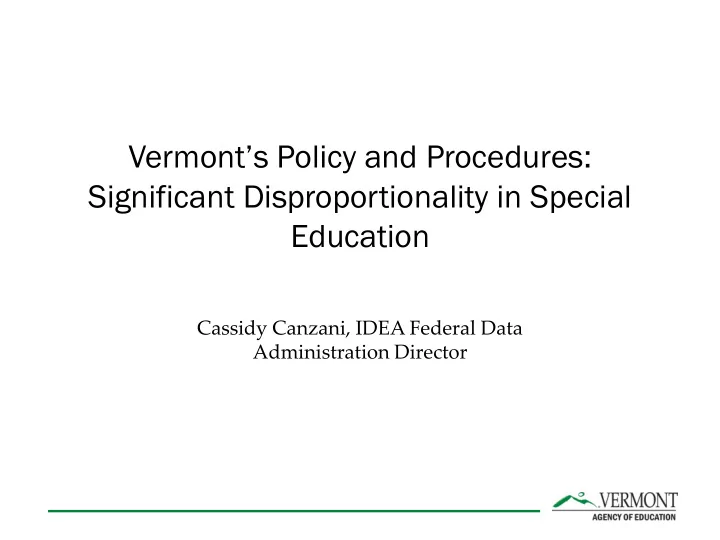

Vermont’s Policy and Procedures: Significant Disproportionality in Special Education Cassidy Canzani, IDEA Federal Data Administration Director
What Is Significant Disproportionality? • What does “significant disproportionality” mean? • What categories are measured?
What Is Significant Disproportionality? • One of three equity requirements of the IDEA: – Disproportionate Representation – Significant Discrepancy – Significant Disproportionality
What Is Significant Disproportionality? • Measurement of racial and ethnic disparity in special education outcomes – Overrepresentation of a racial or ethnic group in a category • Disproportionality becomes significant when the overrepresentation exceeds a defined threshold
What Is Significant Disproportionality? • Federal law requires states to annually examine data by race or ethnicity in the state and all districts with respect to: – Identification of children as having a disability or one of six particular impairments – Placement of children in restrictive educational settings – Incidence, duration, and type of disciplinary removals
Categories egories of Ana naly lysis: sis: Iden entifi ification cation For children ages 3 through 21: • Identification as children with disabilities • Identification as children with the following impairments: – Intellectual disabilities – Specific learning disabilities – Emotional disturbance – Speech or language impairments – Other health impairments – Autism
Categories of Analysis: Educational Environment For children with disabilities ages 6 through 21: • Placement inside a regular class less than 40 percent of the day • Placement inside separate schools and residential facilities, not including: – Homebound or hospital settings – Correctional facilities
Categories of Analysis: Discipline For children with disabilities ages 3 through 21: • Out-of-school suspensions and expulsions of 10 days or fewer • Out-of-school suspensions and expulsions of more than 10 days • In-school suspensions of 10 days or fewer • In-school suspensions of more than 10 days • Disciplinary removals in total, including: – In-school and out-of-school suspensions – Expulsions – Removals by school personnel to an interim alternative education setting – Removals by a hearing officer
The Final Rule • Enforces a standard methodology for all states with some flexibility • Flexible elements are set with stakeholder input
Standard Methodology: Risk Ratios • Risk: portion of a racial/ethnic group experiencing an outcome • Risk Ratio: A racial/ethnic group’s risk of an outcome vs everyone else’s risk of the same outcome
Standard Methodology: Risk Ratios • Risk: portion of a racial/ethnic group experiencing an outcome • Risk Ratio: A racial/ethnic group’s risk of an outcome vs everyone else’s risk of the same outcome
State-Selected Variables • Thresholds • Minimum cell and n sizes • Number of years of data • Reasonable progress
Thresholds
Thresholds • States must determine the threshold for risk ratios over which disproportionality is considered significant • A threshold must be determined for each category of analysis – Thresholds can be the same or different across categories of analysis – Thresholds must be the same across racial and ethnic groups • Thresholds must be reasonable
Minimum Cell and N Sizes
What Are Cell and N? • Cell size: number of students experiencing a certain outcome • N size: number of students in the group that could experience that outcome
Minimum Cell and N Sizes • Small populations result in large swings in risk calculations with the entrance or exit of just 1 student
Minimum Cell and N Sizes • States must determine minimum sizes for analysis groups • Minimum cell and n sizes must be determined for each category of analysis – Minimums can be the same or different across categories of analysis – Minimums must be the same across racial and ethnic groups
Minimum Cell and N Sizes • Minimum cell and n sizes must be reasonable • Range of values considered presumptively reasonable: – Cell size: 1 through 10 – N size: 1 through 30
Number of Years of Data
Number of Years of Data • States may use multiple years of data to perform significant disproportionality analysis • Only risk ratios above the threshold for the selected number of years would be identified as significantly disproportionate
Reasonable Progress
Reasonable Progress • If using multiple years of data to perform significant disproportionality analysis, states may set criteria for reasonable progress • Only risk ratios above the threshold for the selected number of years and failing to improve by the state- designated reasonable progress standard each year would be identified as significantly disproportionate
Recommend
More recommend